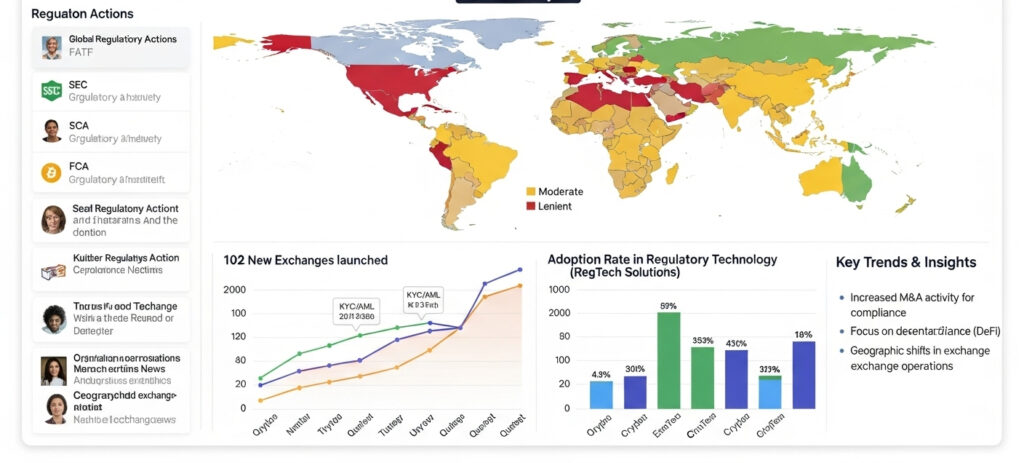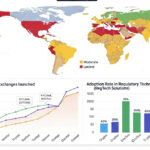As digital assets continue expanding across global markets, the regulatory landscape surrounding cryptocurrencies has become one of the most influential factors shaping how trading platforms operate. Governments, financial authorities, and international agencies have started implementing strict compliance frameworks to regulate the trading, custody, taxation, and transaction monitoring of crypto assets.
These regulations varying significantly across regions directly impact crypto exchange development, influencing technological architecture, operational strategies, user onboarding flows, liquidity practices, and security implementation.
Understanding these regulations is essential for any organization planning to build or scale a trading platform. Whether deploying a centralized exchange, a hybrid model, or a multi-chain trading ecosystem, businesses must understand how global regulatory expectations shape infrastructure, compliance tools, data policies, and product features.
1. Why Regulation Is Becoming Central to Exchange Development
Crypto exchanges have grown from niche trading hubs into global financial platforms. With billions of dollars exchanged daily, regulators are increasingly involved to ensure consumer protection, prevent financial crimes, and promote responsible market behavior.
This is why regulatory strategy has become a foundational part of crypto exchange development. Compliance directly affects the architecture, user flows, data privacy mechanisms, and reporting systems of any trading platform.
Key global regulatory drivers include:
-
Growing institutional participation
-
Expanding cross-border trading activities
-
High-profile exchange hacks or collapses
-
AML and counter-terrorism financing obligations
-
Consumer protection and data security
-
Tax enforcement and reporting accuracy
A crypto exchange development company must design platforms that can adapt to evolving laws while maintaining security, speed, and market accessibility.
2. The Regulatory Frameworks That Shape Exchange Development
Each region approaches cryptocurrency governance differently. These differences influence how platforms structure user verification, transaction monitoring, wallet operations, and licensing models.
United States
The U.S. has a complex structure involving:
-
SEC for securities tokens
-
CFTC for derivatives and commodity-related assets
-
FinCEN for AML/CTF requirements
-
State-level licensing such as the New York BitLicense
These rules require extensive KYC/AML systems, transaction monitoring tools, user risk scoring, and secure data retention core components addressed during cryptocurrency exchange software development.
European Union
The EU introduced MiCA (Markets in Crypto-Assets Regulation), which focuses on:
-
Licensing for crypto asset service providers
-
Consumer safeguards
-
Transparency and operational requirements
-
Stablecoin issuance frameworks
MiCA influences wallet design, custody operations, and exchange governance rules.
United Kingdom
The FCA mandates:
-
Strict AML registration
-
Transaction risk monitoring
-
Custody segregation standards
This affects how crypto exchange development services integrate compliance analytics and monitoring modules.
Asia-Pacific Regions
Regulations vary widely:
-
Japan requires exchange registration and strict custody standards
-
Singapore offers licensing through its Payment Services Act
-
South Korea mandates real-name bank account integration
-
India fluctuates with tax policies and evolving compliance norms
Such diversity means platforms targeting Asia require adaptable compliance frameworks.
Middle East
Countries like the UAE and Bahrain provide clear licensing structures through their financial authorities, promoting innovation while enforcing robust compliance.
Latin America & Africa
Many regions are developing new frameworks, often centered around:
-
Taxation
-
AML controls
-
Stablecoin policies
These emerging markets create new opportunities but demand flexible exchange systems.
Across all jurisdictions, crypto exchange platform development must incorporate customizable compliance logic to ensure long-term operational viability.
3. Impact of Regulations on Exchange Architecture
Regulations significantly influence technical development decisions, particularly around data flows, identity verification, reporting, and auditing.
Key architectural impacts include:
KYC and Identity Verification
Platforms must integrate:
-
Document verification systems
-
Biometric authentication options
-
User risk scoring models
-
Automated onboarding decision engines
These tools affect frontend UX, backend automation, and database structure.
AML Monitoring
Real-time monitoring is essential for:
-
Detecting suspicious transaction patterns
-
Flagging high-risk addresses
-
Enforcing withdrawal limits
-
Blocking risky trading behavior
AML logic becomes a central component in cryptocurrency exchange software development.
Data Storage and Privacy
Regulations like GDPR enforce:
-
Encrypted data storage
-
Data minimization
-
User data deletion workflows
-
Transparent data use policies
This shapes the entire backend architecture.
Licensing Requirements
Some jurisdictions require:
-
Operational segregation
-
Clear governance policies
-
Capital adequacy
-
Insurance for user assets
These requirements influence wallet infrastructure and operational planning.
4. Security Standards Driven by Global Regulations
Security expectations have increased significantly across global regulatory bodies. As a result, security architecture has become a critical component of crypto exchange development.
Common regulatory-driven security standards include:
-
Multi-signature custody systems
-
Cold storage requirements for a portion of user funds
-
Penetration and vulnerability testing
-
Transaction risk scoring
-
Anti-DDoS infrastructure
-
Hardware-based security modules
A crypto exchange development company integrates these standards to reduce the risk of breaches and strengthen user trust.
5. How Regulations Shape Liquidity and Market Operations
Liquidity management is deeply influenced by regional rules. Regulations determine how platforms can:
-
Access liquidity providers
-
Offer trading derivatives
-
Provide leverage or margin trading
-
Support stablecoins or security tokens
-
Permit cross-border transactions
For instance:
-
The U.S. has strict rules for derivatives trading
-
The EU’s MiCA affects stablecoin liquidity
-
Asian markets may require local banking partnerships
These requirements guide trading engine logic, market-making strategies, and liquidity aggregation in crypto exchange development services.
6. Wallet and Custody Regulations
Wallet infrastructure requirements differ across jurisdictions and significantly influence crypto exchange platform development.
Key regulatory expectations include:
-
Segregated custody of user assets
-
Audited reserve proof
-
Clear hot and cold wallet allocation policies
-
Withdrawal risk scoring
-
On-chain transaction monitoring
Many regions require exchanges to maintain robust incident response procedures and transparent custody practices, further shaping wallet architecture.
7. Licensing and Jurisdiction Selection for Exchange Operators
Choosing the right jurisdiction affects:
-
Tax obligations
-
Banking partnerships
-
User trust and global reach
-
Operational cost
-
Required certifications
Common jurisdictions for licensing include:
-
UAE
-
Singapore
-
Estonia
-
Lithuania
-
United States (state-based)
-
United Kingdom
-
Japan
-
Australia
Businesses must align licensing decisions with platform functionality, long-term expansion plans, and targeted user groups.
8. Compliance Automation as a Trending Development Requirement
As regulations become more complex, automation is emerging as a major trend in crypto exchange development.
Modern platforms integrate automated systems for:
-
Real-time identity verification
-
Transaction monitoring
-
Reporting and data collection
-
Compliance alerts
-
Wallet risk scoring
-
Behavioral analytics
These tools reduce the operational burden of manual compliance and ensure consistency during rapid scaling.
9. How Regulatory Evolution Influences Innovation
While regulation can create challenges, it also encourages innovation. Developers are now creating:
-
More transparent trading engines
-
Multi-chain compliance-ready wallet systems
-
On-chain analytics tools
-
Advanced AML machine learning models
-
Modular compliance frameworks
These trends are shaping the future of cryptocurrency exchange software development by improving safety, usability, and global compatibility.
10. The Future of Regulation and Its Influence on Exchange Development
Global regulatory frameworks will continue evolving, pushing exchanges to adopt:
-
More standardized compliance systems
-
Real-time blockchain forensics tools
-
Enhanced KYC verification technologies
-
Stronger transparency and audit features
-
Greater accountability for custody operations
-
Interoperable regulatory reporting APIs
Crypto exchange development will increasingly revolve around building platforms that are adaptable, compliant, scalable, and secure.
Conclusion
Global cryptocurrency regulations have transformed the way trading platforms are designed, built, and operated. From user verification to transaction monitoring, wallet architecture to liquidity management, regulations influence every layer of crypto exchange development. A business entering this field must understand jurisdictional differences, long-term compliance expectations, and the evolving landscape of crypto governance.
Whether working internally or with a specialized crypto exchange development company, businesses must treat regulations as a core design principle rather than an afterthought. Effective cryptocurrency exchange software development now depends on integrating compliance-ready frameworks, secure infrastructure systems, scalable trading logic, and continuous monitoring tools.
Regulation will remain one of the most powerful forces shaping crypto exchange development services. Organizations that build adaptable, compliant, and secure platforms will be better positioned to thrive in the global digital asset economy.



